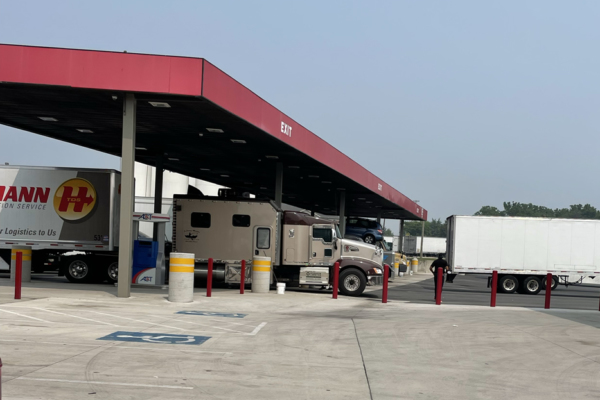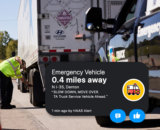Article created for the July digital issue of
New fintech startups can help truckstop and travel center operators grow gallons, and they may also help operators increase inside sales and cut costs.
Here are more considerations for travel center operators looking at working with new fintech providers inside sales growth, fees and customer satisfaction.
Read Fintech Companies Offer Options for Drivers and Truckstop and Travel Plaza Operators for more on this topic.
Increasing Inside Sales
With Mudflap, app users receive a code that they go inside and show the fuel desk cashier.
Because drivers have to go inside, it is creating additional foot traffic in the store. “If you’re going to use Mudflap, you’re going to go in to use that code, so you are going to walk past the items,” said Sanjay Desai, CEO and founder of Mudflap. “Our case studies have shown the Mudflap is spending far more on average on basket size than a typical customer at the same truckstop because our customer is going to go inside every time.”
However, Darren Schulte, vice president of membership for NATSO, said greater gallons and increased foot traffic don’t always mean stronger inside sales if locations aren’t doing things to drive those sales.
Reducing Fees
Interchange fees can add up for operators, and Tyler Raugh, head of business development and strategic sales for AtoB, said the company can help locations, especially independents, lower interchange fees.
Mudflap charges for every transaction. “That fee varies based on size of merchant, but it is dramatically lower than what most independents and regional players pay,” Desai said. “Our interchange is in the 1% range. We push the vast majority of the value to the driver in the form of a discount instead of it going to interchange to one of the card companies. That has been an added benefit for merchants.”
Saving Drivers Money
Schulte said that one of the benefits of these new offerings is the customer experience, which may be a reason for a location to partner with a provider.
Drivers are increasingly interested in paying with an app, Desai said. “Cards can get lost or damaged or the strip stops working. There are all kinds of issues. Every driver has their phone with them,” he said.
Malik Yousif with Marion Travel Plaza, said he is excited about the savings independent operators can take advantage of with Mudflap. “The small guy gets to have their cake and eat it too, which in this industry is not very common. If you told me that me a small fleet with one to five trucks can pay the same price as a JB Hunt, FedEx or Amazon Prime, I’d call you crazy, but with Mudflap you can,” Yousif said.
Desai said the Mudflap app features a map with all of its partner locations. “The driver always knows what the discount is going to be when they buy at that fuel stop,” he said, adding that the discount is instant.
Mudflap is free to drivers and they don’t pay any transaction fees. When drivers decide where they want to fuel, they select the network and Mudflap charges them through the app. Then, Mudflap takes the funds and settles with its merchant partners. “The partner has 100% guarantee for us that Mudflap will pay,” Desai said.
Raugh said smaller carriers tend to be focused on the fees on traditional cards, which can add up to six cents per gallon. “We’ve eliminated all usage fees. That is a really big benefit,” he said.
Tony Spuzello, director of commercial fuels for Casey’s General Stores, said AtoB is targeting tires, service and maintenance pieces in addition to fuel. “Their offer is simple to understand. Sometimes the fleet card deals can get convoluted,” he said. “It isn’t anything the world hasn’t seen, but it is new enough and different enough from the legacy cards that it will maybe attract an audience that hasn’t looked at it before.”
Some fleets like the additional security new providers can offer, especially with fuel card misuse on the rise. “We’ll see 5% or more of spend on incumbent fuel cards isn’t going into that company’s vehicle,” Raugh said. “We’re a technology company, and we’re about to geo-co-locate the truck with telematics. The driver unlocks the card with their cell phone, and we know all three—the vehicle, card and driver—are all in the same location. It protects drivers and fleets from any type of misuse.”
Fleets can also set time-of-day controls or block different types of merchants. “It is a highly controllable set,” Raugh said.
Mudflap’s Desai said fleets have the ability to turn off a driver’s account by deactivating the app.
Signing On
Both AtoB and Mudflap said it is easy for operators to partner with the companies.
“The agreement is two pages long. It is very easy to sign. There is not a big commitment and then we can get you set up on the marketing platform,” Raugh said, adding that locations tend to offer some type of discount to drivers and there are various forms of that they can select.
Mudflap provides every partner location with a Mudflap tablet, which cashiers use to enter the code on drivers’ apps to authorize them to fuel. “We call it a zero-risk model from the standpoint there is no IT or integration required,” Desai said. “We’ve had customers launch literally 24 hours after they sign with us. We overnight the tablet and we’re ready to go. It is built to be super easy and friendly for the retail space.”
Yousif said Mudflap is easy for cashiers to use. “However, we live in a day and age of ever rotating employees and employees that are extremely distracted by their work and their phones. I monitor my Mudflap dashboard to make sure everything that has been redeemed is being paid,” he said. “If an employee didn’t close out a transaction on the tablet, I get a call in one to two hours and can call the cashier and have them close it out.”
While there are many benefits to partnering with new fintech companies, there are several things operators need to be aware of before striking up a new partnership.
// This article was created for Stop Watch magazine, the magazine of the NATSO Foundation. The NATSO Foundation is the research, education and public outreach subsidiary of NATSO, Inc. The NATSO Foundation provides programs and products to strengthen travel plazas’ ability to meet the traveling public's needs through improved operational performance and business planning. Visit www.natsofoundation.org for more information. (Donate to the NATSO Foundation here.)
Subscribe to Updates
NATSO provides a breadth of information created to strengthen travel plazas’ ability to meet the needs of the travelling public in an age of disruption. This includes knowledge filled blog posts, articles and publications. If you would like to receive a digest of blog post and articles directly in your inbox, please provide your name, email and the frequency of the updates you want to receive the email digest.




